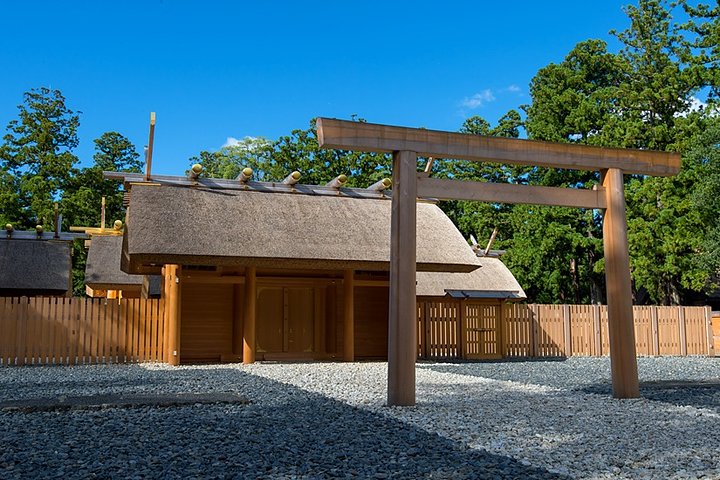
Mie 3-hour Sightseeing Chartered Taxi | Ryogu & Betsugu, Ise Jingu & Goshuin spots | Coupon Included
This chartered taxi allows you to smoothly and efficiently tour Ise city in Mie prefecture. Visit Ryogu of Ise Jingu and some little-known spots all by yourself! This tour includes a coupon for a walk-and-eat at Okage-yokocho, which allows you to enjoy a stroll on your own after visiting the Naiku shrine. Enjoy a private trip with a flat-rate chartered taxi!
- A sightseeing taxi for visiting Ryogu and Betugu and collecting Goshuin Stamps
- A special coupon for walk-and-eat at Okage-yokocho is also included
- This private tour is perfect for families and groups! Enjoy your tour at your own pace!
Options
Visiting Ise Jingu and Goshuin spots
Additional Info
Departure time is between 8:30 am and 10:30 am, at the time requested by the customer. However, please note in advance that we might not be able to provide the service at the time you request due unforeseeable circumstances
Meeting time is 10 minutes before the designated departure time
The service will be operated with the standard car (4 guests maximum)
What's included in Mie 3-hour Sightseeing Chartered Taxi | Ryogu & Betsugu, Ise Jingu & Goshuin spots | Coupon Included
(Subject to Option Inclusions)







—What You Can Expect—
Enjoy a private trip to Ise Jingu in Mie Prefecture with a flat-rate chartered taxi. Also enjoy a coupon for a walk-and-eat at nearby Okage-yokocho, so you can stroll and indulge your taste buds at the same time! This special deal is perfect for families and couples who want to get away and avoid crowds!
— Tour Info —
- Meeting Place: JR Iseshi Station / Ujiyamada Station
- Ending Place: Naiku, the inner shrine of Ise Jingu
- Departure time: 8:30 am–10:30 am *at your designated time
— Vehicle Info —
- Vehicle type: Mid-size taxi
- Passengers: 4 guests
- Luggage: 1–2 large suitcases
— Spot Info —
- Tsukiyomi-no-miya (月夜見宮)
Tsukiyomi-no-mikoto, a younger brother of Amaterasu, is the deity of Tsukiyomi-no-miya. Another Tsukiyomi-no-miya (月讀宮) is dedicated to Tsukiyomi-no-mikoto and Amaterasu in the same place, but this shrine features the two of them separately. Tsukiyomi-no-miya Shrine is located at the end of Kamiji-dori, which stretches westward from the north gate of the Outer Shrine. Surrounded by many trees, including a centuries year old camphor tree, the Shinto sanctuary has a quiet and peaceful atmosphere that one would not expect in an urban area.
- Jingu Chokokan (神宮徴古館)
The Jingu Chokokan was founded in 1909 as the first private museum in Japan, and is a " comprehensive museum of history and culture" of the Ise Jingu Shrine. The Jingu Chokokan exhibits mainly materials related to festivals, history, and culture in order to provide visitors with a more detailed understanding of the Jingu Shrine. The most impressive exhibits are the restoration of the shrine pavilions and the sacred treasures that are renewed every 20 years when the shrine is moved to a new location during a Shinto ritual. The museum also houses 11 nationally important cultural properties and approximately 13,000 items of history, archaeology, and arts and crafts.
- Tsukuyomi Shrine (月讀宮)
The deity is Tsukuyomi-no-Mikoto, the younger brother of Amaterasu. As the name "Tsukuyomi (月読)" implies, he is the deity who controls the phases of the moon and presides over the days and nights. The four separate shrines, from right to left: Tsukiyomi-no-aramitama-no-miya, Tsukiyomi Shrine, Izanagi-no-miya shrine, and Izanami-no-miya Shrine, are located side by side and are usually visited in order from Tsukiyomi-no-aramitama-no-miya to IIzanami-no-miya.
Inclusions
- Consumption tax
- Taxi fare
- Ise Jingu Naiku-mae Gurutto Mankitsu Coupon
- Surcharge for the use of toll roads
- Parking Fee
- Personal expenses
- Other expenses not mentioned above
- Lunch
- Entrance fee to Jingu Chokokan
- Goshuin Stamps
- Please arrive at the designated location 10 minute(s) before the scheduled departure time, as the tour will depart on time
- [Ise Jingu Naiku-mae Gurutto Mankitsu Coupon]
Get a ticket from the taxi driver and redeem it for your coupon at Senokuniya, the shop in front of Naiku - Please note that we are not responsible for schedule changes due to traffic jams, missed trains, etc.
- If the facilities on the tour including Jingu are suddenly closed, or if the road is closed due to an event in Ise city, the tour may be canceled
Meet
Venues
- JR Iseshi Station1. Departure time is between 8:30 am and 10:30 am, at the time requested by the customer
2. Meeting time is 10 minutes before the designated departure time - Ujiyamada Station1. Departure time is between 8:30 am and 10:30 am, at the time requested by the customer
2. Meeting time is 10 minutes before the designated departure time
Policies
Purchase Summary
- The maximum number of guests is 4 (elementary school students and older)
- Please purchase meals by yourself
- The fees for Goshuin stamps and admission to Jingu museum are not included in this product
- The driver is not a tour guide, so she cannot provide information on sightseeing spots
- There is an overtime charge, if the tour exceeds the required time, please pay the charge on-site
Valid Period
Surcharge
* Extra fee is required if this time is exceeded. Please pay the driver on-site






